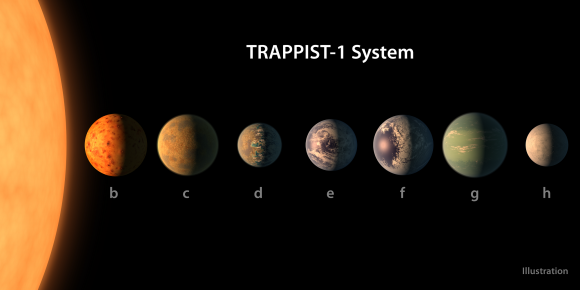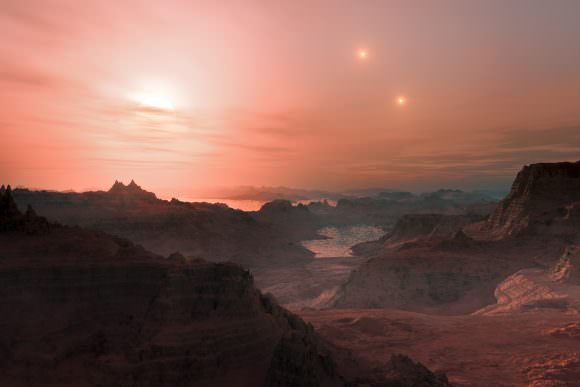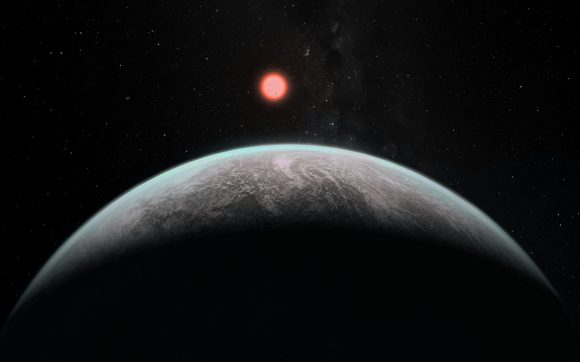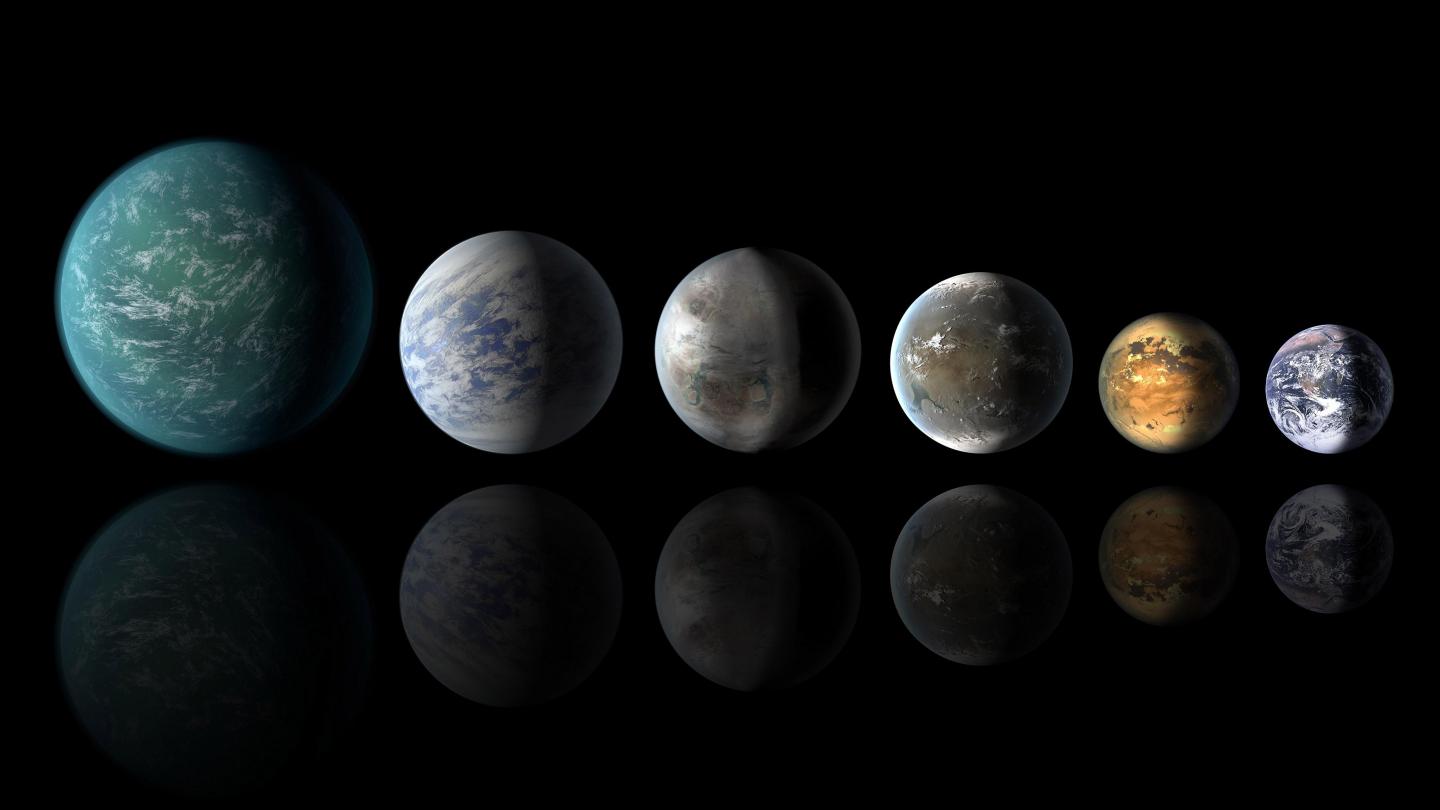When it comes to the search for extra-terrestrial life, scientists have a tendency to be a bit geocentric – i.e. they look for planets that resemble our own. This is understandable, seeing as how Earth is the only planet that we know of that supports life. As result, those searching for extra-terrestrial life have been looking for planets that are terrestrial (rocky) in nature, orbit within their stars habitable zones, and have enough water on their surfaces.
In the course of discovering several thousand exoplanets, scientists have found that many may in fact be “water worlds” (planets where up to 50% of their mass is water). This naturally raises some questions, like how much water is too much, and could too much land be a problem as well? To address these, a pair of researchers from the Harvard Smithsonian Center for Astrophysics (CfA) conducted a study to determine how the ratio between water and land masses can contribute to life.
The study – “Dependence of Biological Activity on the Surface Water Fraction of Planets“, which is being reviewed for publication with The Astronomical Journal– was authored by Manasvi Lingam, a postdoctoral fellow with the CfA’s Institute for Theory and Computation (ITC), and Abraham Loeb – the director of the ITC and the Frank B. Baird Jr. Chair of Science at Harvard University.

To begin, Lingam and Loeb address the issue of the anthropic principle, which has played a major role in astronomy and exoplanet research. In short, this principle states that if conditions on Earth are suitable to accommodate to life, then it must exist for the sake of creating life. Extended to the entire Universe, this principle argues that the laws of physics exist as they do for the sake of giving rise to life.
Another way to look at it is to consider how our assessments of Earth fall into what is known as “observation selection effects” – where the results are directly affected by the type of method involved. In this case, the effects arise from the fact that our search for life beyond Earth and our Solar System require the existence of an appropriately positioned observer.
In effect, we tend to assume that the conditions for life will be abundant in the Universe because we are familiar with them. These conditions the presence of both liquid water and land masses, which were essential for the emergence of life as we know it. As Lingam explained to Universe Today via email, this is one of the ways in which the anthropic principle comes up when searching for potentially habitable planets:
“The fact that the Earth’s land and water fractions are comparable is indicative of anthropic selection effects, that is to say, the emergence of humans (or analogous conscious observers) may have been facilitated by a suitable mixture of land and water.”

Credits: NASA/JPL-Caltech
However, when addressing the many super-Earths that have been discovered in other star systems, statistical analyses of their mean density has shown that the majority have high fractions of volatiles. A good example of this is the TRAPPIST-1 system, where theoretical modelling of its seven Earth-sized planets has indicated that they could be up to 40-50% water by weight.
These “water worlds” would therefore have very deep oceans and no landmasses to speak of, which could have drastic consequences for the emergence of life. At the same time, planets that have little to no water on their surfaces are not considered good candidates for life, given how water is essential to life as we know it.
“Too much landmass is a problem, as it restricts the amount of surface water, thereby making most of the continents very arid,” said Lingam. “Arid ecosystems are typically characterized by low rates of biomass production on Earth. Instead, if one considers the opposite scenario (i.e. mostly oceans), one encounters a potential issue with the availability of phosphorus, which is one of the essential elements for life-as-we-know-it. Hence, this could result in a bottleneck on the amount of biomass.”
To address these possibilities, Lingam and Leob went about analyzing how planets with too much water or landmass could affect the development of exoplanet biospheres. As Lingam explained:
“[W]e developed a simple model to estimate what fraction of the land will be arid (i.e. deserts) and relatively uninhabitable. For the scenario with water-dominated biospheres, the availability of phosphorus becomes the limiting factor. Here, we utilized a model developed in one of our earlier papers that takes into account the sources and sinks of phosphorus. We combined these two cases, used data from Earth as the benchmark, and thus determined how the properties of a generic biosphere would depend on the amount of land and water.”

What they found was that a careful balance between landmasses and oceans (much like what we have here on Earth) is crucial to the emergence of complex biospheres. Combined with numerical simulations by other researchers, Lingam and Loeb’s study indicates that planets like Earth – with its ratio of oceans to landmass (roughly 30:70) – are probably quite rare. As Lingam summarized:
“Thus, the basic conclusion is that the balance of land and water fractions cannot be tilted too much one way or another. Our work also shows that important evolutionary events, such as the rise in oxygen levels and the emergence of technological species, may be affected by the land-water fraction, and that the optimal value could be close to that of the Earth.”
For some time, astronomers have been searching for exoplanets where Earth-like conditions are prevalent. This is known as the “low-hanging fruit” approach, where we attempt to find life by looking for biosignatures that we associate with life as we know it. But according to this latest study, finding such places could be like looking for diamonds in the rough.
The study’s conclusions could also have significant implications when it comes to the search for extra-terrestrial intelligence, indicating that it too is quite uncommon. Luckily, Lingam and Loeb admit that not enough is known about exoplanets and their water-to-landmass ratios to say anything conclusively.

“It is not possible, however, to predict how this affects SETI in a definitive manner,” Lingam said. “This is because we do not yet have proper observational constraints on land-water fractions of exoplanets, and there are still many unknowns in our current knowledge of how technological species (capable of partaking in SETI) evolved.”
In the end, we must be patient and wait for astronomers to learn more about extra-solar planets and their respective environments. This will be possible in the coming years thanks to next-generation telescopes. These include ground-based telescopes like the ESO’s Extremely Large Telescope (ELT) and space-based telescopes like the James Webb Space Telescope (JWST) – which are scheduled to commence operations in 2024 and 2021, respectively.
With improvements in technology and thousands of exoplanets now available for study, astronomers have started shifting from the process of discovery to characterization. In the coming years, what we learn about exoplanet atmospheres will go a long way towards proving or disproving our theoretical models, hopes and expectations. Given time, we may finally be able to determine just how plentiful life is in our Universe, and what forms it may take.
Further Reading: arXiv


Even for planets *with* the right land/water ratio, if there is no tectonic activity (building of new land), then after a billion years or so, all land could be eroded beneath the relatively shallow oceans. Alternately, for planets with a higher water/land ratio, tectonic activity could possibly make *some* land.
Even if very intelligent water creatures were to evolve, no land probably means no technological civilization, since almost all of the industrial processes that we know of depend on fire and oxygen reactions, which only can happen in *air* (ie, above water).
What does this mean for the Fermi paradox? It could mean earth-like planets are *extremely* rare, and therefore, so are the chances of another technological civilization besides us.
This related article about the possible connection between the initial collision with Thea, the formation of the Moon, the loss of crustal material to the Moon, and plate tectonics, is quite interesting.
http://www.spacedaily.com/news/life-01×1.html
https://www.universetoday.com/139738/it-looks-like-plate-tectonics-arent-required-to-support-life/
While some developments in Astronomy reduced the importance of the earth (like the displacement of the earth from the center of the solar system), the Fermi paradox may once again point to the earth being very rare, unique and special, even on a galactic or universal scale. We should treasure our earth, and the unique life that it holds. Even a single extinct creature represents the loss of millions of years of evolutionary diversity.